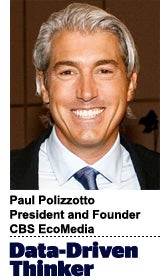 “Data-Driven Thinking” is written by members of the media community and contains fresh ideas on the digital revolution in media.
“Data-Driven Thinking” is written by members of the media community and contains fresh ideas on the digital revolution in media.
Today’s column is written by Paul Polizzotto, founder and president at CBS EcoMedia.
For the advertising industry, the rules of the game are changing fast. Advances in technology are constantly transforming how and when consumers interact with brands. In addition, reaching millennials, who last year were projected to surpass baby boomers as the nation’s largest living generation, requires a different advertising approach.
The bottom line is that consumers in today’s 24/7 multiplatform media environment are demanding highly engaging experiences from advertisers. More than 77% of Americans now own smartphones; Google research indicates that these consumers are looking to connect with brands during “micro-moments,” those brief intervals of time when they turn to their mobile devices.
Since millennials have grown up on gaming, “brands have a unique opportunity to jump on a rising trend that millions of millennials engage with every single day and connect with them in a genuine way,” Google said.
For advertisers looking for new ways to reach consumers, gaming offers an innovative solution.
Why ‘Gamified’ Ads?
About two-thirds of the US population regularly plays video games on a mobile device or console, according to Nielsen. Gamified ads may be the perfect way to attract this audience and have been shown to increase consumer engagement. In one study, game-like ads resulted in engagement rates nearly 6% higher than non-gaming ads, with a 28.8% click-through rate (CTR) – a vast increase over the 3.9% CTR of standard advertising.
In one gamified ad, M&M posted a photo on Facebook and asked users to find the pretzel hidden amongst the M&Ms. The results – including 25,000 likes, 6,000 shares and 10,000 comments on the company’s Facebook page – represented major gains in audience engagement and social shares.
Uber also experimented with gamification with UberDRIVE, a mobile game app designed to engage current Uber drivers and recruit new ones. And the online puzzle-solving game Foldit challenged its community of gamers to discover an unknown enzyme associated with the reproduction of HIV, a profound example of how gamification can be used for social good.
The Challenges For Advertisers
When designing “gamified” campaigns, advertisers must be careful not to create an overly complicated experience. If any aspect of the game is unduly cumbersome, audiences will quickly lose interest. Therefore, it is important to ensure that every step, from downloading the app to the onboarding process, is intuitive and incentivizing. The M&M campaign, for example, was based on the elegantly simple concept of hide-and-seek.
In addition to simplicity and ease of use, the most successful games are built with an element of choice. The ShopKick app, for example, which gamifies the shopping experience, allows players to earn points when shopping, which can then be redeemed for a gift card to the store of the player’s choosing.
Allowing consumers to select their own rewards increases player buy-in. And the more invested a player is, the more satisfying the game experience will be – which, in turn, increases user engagement and the likelihood that the ad will be shared.
Another key element of an effective gamified ad is a strong feedback loop with frequent and timely information about how successfully players are advancing toward the goal. We all compare ourselves to others, we all want to win and we like to participate in a shared experience. Advertisers have myriad data points at their disposal, including individual standings in the game’s community rankings, which can be used to meet these needs and keep players motivated and encourage continued play.
Nike’s NikeFuel campaign, for example, allows users to compete against one another to log the highest amount of daily physical activity. The game both motivates users to become more active and encourages them to share their results on social media, thus creating greater brand awareness.
Providing additional rewards for players in special categories, such as those with the highest scores by geographic region, is another way to maintain player interest.
Player data can also be an important source of information for advertisers, revealing how many people are playing the game, whether they are male or female, their age, their geolocation, which rewards they are choosing and how much time they spend playing.
Gamified Ads Can Be A Win-Win
Many have observed that online, we tend to segregate into particular communities. A 2014 Pew survey, for example, documented the ways in which liberals and conservatives were polarized in their online associations. If well-executed, a gamified ad can bridge these online divides, giving players the opportunity to form their own communities organized around gameplay. In addition, marketers can offer rewards that incentivize players to invite others to join, growing the game community and evangelizing the brand in the process.
As consumers actively engage with, and derive entertainment value from, a gamified ad, they will be inclined to share about it, making the campaign a win-win for both consumer and advertiser.
Follow Paul Polizzotto (@PaulPolizzotto), CBS EcoMedia (@EcoMediaCBS) and AdExchanger (@adexchanger).











